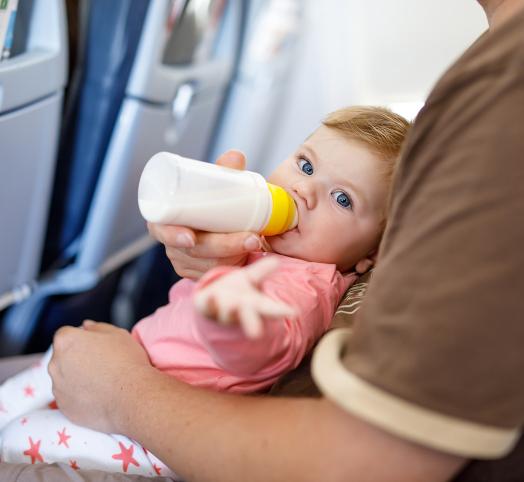Flying with your baby
Updated on March 22, 2023
Created on July 24, 2019
Find your nearest point of sale here
Updated on March 22, 2023
Created on July 24, 2019

Is there an age limit? Babies are allowed to fly at a much younger age than you might think. If a baby is healthy and not born prematurely, most airlines allow them to fly from the age of one week for short flights, and three weeks for long-haul flights.
However, if you can delay your journey, it’s best to wait until your baby has had its first vaccinations because viruses spread more easily in confined spaces. Your baby is too young to be vaccinated for certain diseases (malaria, yellow fever, etc.) so it’s best to avoid travelling to countries affected by them.
If your baby was born prematurely or has health problems, always ask your doctor before flying.
Prepare for your trip Your baby is subject to the same rules as you are. Avoid unpleasant surprises at the airport by knowing exactly what you need to take with you. He or she needs proof of identity to travel inside Europe, and his or her own passport (and visa, if necessary) for the rest of the world.
Make sure you think ahead: it takes several weeks to get all of these papers together.
Warn your airline that you are going to be travelling with a baby when you book your tickets. You’ll be given a more spacious seat, a cot or even a bed for your baby, depending on the airline. Most airlines also accept Moses baskets or car-type seats. If you want a separate seat for your baby, you’ll need to ask for one.
Otherwise, all babies under the age of two travel on their parent’s lap. It’s cheaper that way, but not very comfortable.
Folding prams are sometimes accepted on-board, whereas large prams are placed in the hold, so make sure you do your research beforehand.
It’s a good idea to take a carry cot, which will prove handy after you’ve checked in.
Top tips for a peaceful trip Make the most of your baby’s cabin luggage allowance to take an extra supply of nappies, wipes and a change of clothes - for you and your baby! If he or she knocks a drink over you or vomits on your shoulder, you won’t have to spend the next five hours wishing you’d packed a spare top.
Although adults are not allowed to take liquids on-board, this rule does not apply to babies. You’re allowed to take powered milk into the cabin, along with bottled water and small pots to feed your baby. Security staff are authorised to ask you to taste them before allowing you on-board - we warned you!
For the sake of convenience, pack the baby’s food and drink in containers. When it comes to other liquids - water for cleaning, cleansing cream or a physiological serum - you can only take 100 ml of each, so stick to samples and travel packs. Your baby’s ears may hurt on take-off or landing, which is when the air pressure changes.
The only way to “pop” their ears is by getting your baby to suck on a bottle, dummy or your breast. If he or she has a blocked nose, clean it before take-off and just as the plane starts its descent.
Planes are air-conditioned and it can get a little chilly, so remember to cover your baby and pack a blanket and hat along with his or her other travelling clothes. It’s very easy to catch a cold! Keeping your baby amused Although new-born babies will probably be happy to sleep in your arms through most of the journey, older children are less likely to sit still throughout the flight. There’s no easy fix, but here are a few tips to help you. For long-haul flights, the best advice we can give is to travel at night: both you and your baby are more likely to sleep through the flight that way.
Remember to take some of your baby’s favorite toys on-board - just make sure they don’t make a noise to avoid annoying your fellow passengers! It’s best to take books, comfort blankets, small cars, drawing equipment and other things that he or she can play with in silence, depending on their age, of course.
Distract your baby by pointing out things around him or her, such as people walking down the aisles, the stewards and stewardesses, or even the sky and clouds. It’s a great way to discover a new world!
Cartoons are usually available on the in-flight entertainment system - it’s a good way to distract your baby for a few minutes.
If your baby is irritable or bored, walk them along the aisles - if the airline staff agree, of course! The change of scene will do them good.